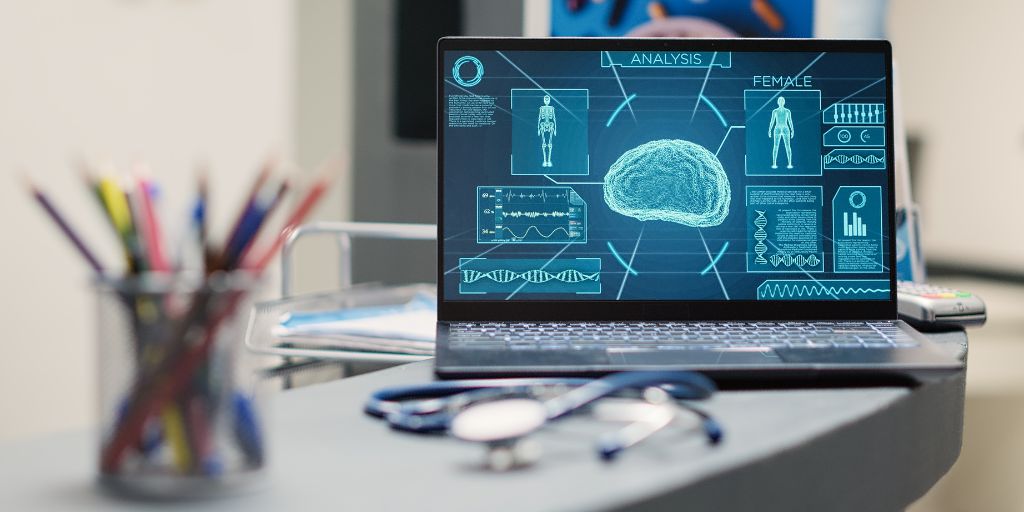
After years of being used as a marketing buzzword, the world is finally starting to see what real artificial intelligence (AI) is capable of – and there aren’t many sectors that boast more potential than healthcare.
Deloitte has found that AI in the medical sector has the potential to save a mind-bending $360bn over the next five years – not to mention four hours of the working week for doctors and nurses. The automation of workflows, analytics, and the navigation of incredible volumes of data in mere seconds can entirely transform the everyday routine of medical practitioners and bring visibility to additional data.
So, what are those opportunities? Now that AI is here to stay, what exactly can it do for us?
Streamlining the mundane
Let’s start with the easiest to understand: AI is capable of administrative tasks at a greater scale and speed than any human could ever be. From finding patient records to paying bills, the ability to outsource energy-sapping, time-consuming tasks that kill the working day and contribute to burnout is a huge boon.
Beyond that, AI is exceptional at data analytics, capable of recognising complex patterns amidst a sea of data points – and thereby enabling medical professionals to make genuinely data-driven decisions. These insights might make a direct impact on an individual’s care plan, or it might be something hospital-wide, like tweaking logistics to accommodate peaks and troughs in hospital admissions.
Not only does this happen faster than the manual equivalent, but it also drastically cuts down on human error. AI can’t lie; it can only do as instructed, based on the data it is fed. Beyond the initial request from an employee, the exposure to human error is dramatically reduced. As long as the data is accurate, the output will correspond.
The advent of Generative AI – the ability not just to automate, but to create – allows for the generation of key forms, documents, and reports based on existing data, which can save hours every day in some administrative or back-end roles. One great example is accrediting clinical staff.
This combines particularly well with Robotic Process Automation (RPA), which uses a software ‘robot’ as something of a back-office processing centre to execute key processes for an organisation. RPA can use paperwork as reference points to perform tasks like booking appointments, billing patients, and sharing key data with relevant members of staff.
Boosting workforce wellness
Speaking of staff, it’s worth focusing in much more detail on the mental health benefits that come with AI entering the workplace.
Physical and mental strain are both huge factors in managing and maintaining a healthcare workforce. Up to a third of staff absences in NHS Wales in 2023 were due to stress, while the Royal College of Nursing suggests that the average nurse takes a week off a year due to stress.
This makes AI’s aforementioned capacity to eliminate admin a huge relief – and we see that taken even further through the integration of Natural Language Processing (NLP). NLP, in simple terms, enables employees to navigate huge repositories of data by asking specific, everyday questions. Rather than navigate a cumbersome, confusing legacy system for the information you want, you can literally just ask for it!
NLP can also transcribe meetings and summarise consultations. Again, the healthcare professionals can outsource menial tasks, and instead focus their efforts and energies on the human patient in front of them.
In the post-COVID era, of course, all of these things need to be able to take place within a remote working framework. That these AI systems can function in the cloud allows practitioners to access key information wherever they go, no longer confined to their specific practice or physical location.
All of this ultimately serves to buy healthcare professionals not only more headspace, but more time in the day to achieve the things that matter to them. In sidelining tedious, repetitive tasks, they have more energy and more resources with which to deliver the best care possible – both eliminating many of the small frustrations of their day-to-day, and instead delivering much higher levels of both customer and employee satisfaction.
Radiology and digital pathology: a deep dive
To take a deeper dive into other specific aspects of healthcare, one standout example is radiology – the use of images to diagnose, treat, and manage medical conditions and diseases. Companies like deepc are looking to deliver AI operating systems for radiologists that enable extra functionality, as well as integrating with the administrative systems we’ve already discussed. In the same vein, Tribun Health creates similar workflows as radiology but is specific to pathology. These provide workflow efficiencies by providing workflow orchestration tools for quality control, positive findings, and auto assignments to name a few as well as the offering of diagnostic algorithms.
Such systems can analyse incredible volumes of imaging data in seconds, enabling diagnoses – and therefore treatment – to begin much faster. For conditions where time is often of the essence, such as cancers, cancer grading or injuries to the brain, the time saved can make all the difference in the patient’s outcome.
What’s more, these images – and the AI’s assessment of them – can help to standardise interpretation across the practice and the wider healthcare network. Being able to work from the same frame of reference, and agree on key details, is vital if radiologists aren’t to waste time and energy debating different diagnoses and treatments. Any AI integrated into the workforce needs to be absent of bias to deliver this consistency, helping to guarantee the standard and type of care that a patient can expect.
Images can also be used as training data for AI, meaning that results become more and more accurate as more and more successful diagnoses are made. The machine learning (ML) algorithms that underpin AI are trained by firing images at an incredible rate through the AI system; the more data made available for training, the more robust the AI used to identify them.
Radiology, then, nicely encapsulates many of the natural strengths that AI can bring to healthcare. The acceleration of data analytics in imaging delivers faster, better results for patients, while again protecting radiologists from overexertion and mental fatigue – and even while this is happening, the AI is capable of
improving itself to deliver these results more reliably.
Healthcare’s AI-driven future
The future of healthcare is set to be reshaped in ways we could scarcely imagine just a decade ago, with AI poised to lead the charge. As we stand on the brink of this technological revolution, it’s clear that AI will not merely support the healthcare industry—it will help to redefine it.
The efficiencies AI brings are only the beginning. We’re looking at a future where the precision of AI- driven diagnostics, the power of data analytics, and the elimination of repetitive tasks will allow healthcare professionals to focus on what truly matters: patient care.
The future, powered by AI, is one where healthcare is smarter, more responsive, and more inventive.










